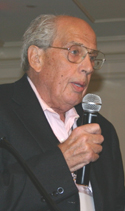2007 年早衰症研究基金会
早衰症研讨会
|
|
会议日期和时间:
|
|
2007 年 11 月 12 日星期一晚上至 2007 年 11 月 14 日星期三下午。
地点: 马萨诸塞州波士顿 Colonnade 酒店
此次研讨会共有近 100 名参与者和 30 张海报,是科学家和临床医生的又一次成功聚会,他们的工作继续对这一快速发展的研究领域产生重大影响,为下一轮治疗和治愈早衰症的进展奠定了基础。
发言者包括心脏病、衰老、遗传学和核纤层蛋白病等领域的顶尖科学家。
每一个 之前四次早衰症研讨会 对早衰症研究进程产生了深远影响,帮助将早衰症研究从最低限度的科学认可提升为一个充满活力的研究领域,其中包括研究衰老和心血管疾病机制的新途径。之前的研讨会提供了一个同事环境,并在开放讨论期间激发了思想交流,从而促成了许多合作。这种氛围在 2007 年的研讨会上得到了继续培养。研讨会上还有机会听取和会见患有早衰症的家庭的意见。

“今天生成和讨论的数据的深度和广度确实令人叹为观止。” 弗朗西斯·柯林斯 (Francis Collins) 医学博士、哲学博士,绘制了人类基因组的国家人类基因组研究所所长、研讨会发言人和早衰症基因的共同发现者。

几乎所有过去和现在的 PRF 研究资助者都参加了今年的会议。
- 心血管疾病: Marie Gerhard-Herman 博士(哈佛大学,波士顿)、Elizabeth Nabel 博士和 Francis Collins 博士(美国国立卫生研究院,贝塞斯达)的演讲主要集中在早衰症儿童和早衰症小鼠模型的心脏病特征上。演讲将早衰症与一般老龄人口的心血管疾病进行了比较。Nabel 博士展示了美国国立卫生研究院自然史研究的持续分析数据,而 Collins 博士则展示了 FTI 药物治疗对早衰症小鼠效果的令人振奋的新数据
-
老化: Karima Djabali 博士(哥伦比亚大学,纽约)探索了早衰蛋白“progerin”不仅存在于早衰儿童中的证据,也存在于非早衰人群的细胞和组织中。田纳西州立大学的 Yue Zou 博士重点介绍了衰老细胞和早衰细胞中的细胞信号转导和细胞周期的比较,两位演讲者都强调,通过研究早衰,我们可以更好地了解细胞衰老。
-
核纤层蛋白病:导致早衰症的基因称为“层蛋白”,与该基因有关的疾病称为层蛋白病。Joanna Bridger 博士(英国布鲁内尔大学)和 Jan Lammerding 博士(波士顿哈佛大学)通过比较早衰症和层蛋白病细胞异常与正常细胞特性的研究,展示了研究每种层蛋白病如何为所有这些疾病提供有价值的信息。
-
层蛋白生物学和核膜蛋白: Robert Goldman 博士(西北大学,芝加哥)、Lucio Comai 博士(南加州大学,路易斯安那州)、Michael Sinensky 博士(东田纳西州立大学)和 Bryce Paschal 博士(弗吉尼亚大学医学院)的演讲重点介绍了非患病状态和早衰症中正常和异常蛋白质加工的生物化学各个方面。研究表明,加工途径中的几个点可能引导我们找到治疗或治愈早衰症的方法。研究正常和异常途径对于实现这些目标至关重要。
-
早衰症的骨骼、内分泌、细胞外基质和皮肤病学研究: 凯瑟琳·戈登博士(波士顿儿童医院)将早衰症的自然病程与骨质疏松症、胰岛素抵抗和硬皮病等疾病进行了比较。数据来自波士顿儿童医院进行的研究的基线结果以及 PRF 医疗和研究数据库的临床图表分析。斯蒂芬·杨博士(洛杉矶加州大学洛杉矶分校)介绍了早衰症的脂肪减少研究。
-
治疗策略:
一个) 使用正在进行的临床试验的设计和原理的介绍 法呢基转移酶抑制剂 由其主要负责人 Mark Kieran 博士介绍,并讨论了 FTI 对其他疾病过程的治疗结果。Francis Collins 博士还介绍了 FTI 治疗早衰症小鼠模型后病情改善的后续研究。b) 干细胞替代的效果: 最近的几篇评论提出,早衰症患者细胞死亡率增加,导致组织稳态无法维持,这可能是导致疾病进展的主要因素,而补充间充质干细胞可能会克服这些缺陷。Irina Conboy 博士(加州大学伯克利分校)介绍了早衰症专项研究的结果以及干细胞替换的影响
c) 其他潜在策略 西班牙奥维耶多大学的 Carlos Lopez Otin 博士对早衰症小鼠模型进行了新药治疗,而美国国立卫生研究院的 Tom Misteli 博士则正在利用新开发的小分子药物筛选寻找早衰症的新型药物治疗方法。
 点击这里 获得 PDF 版本 议程
点击这里 获得 PDF 版本 议程


